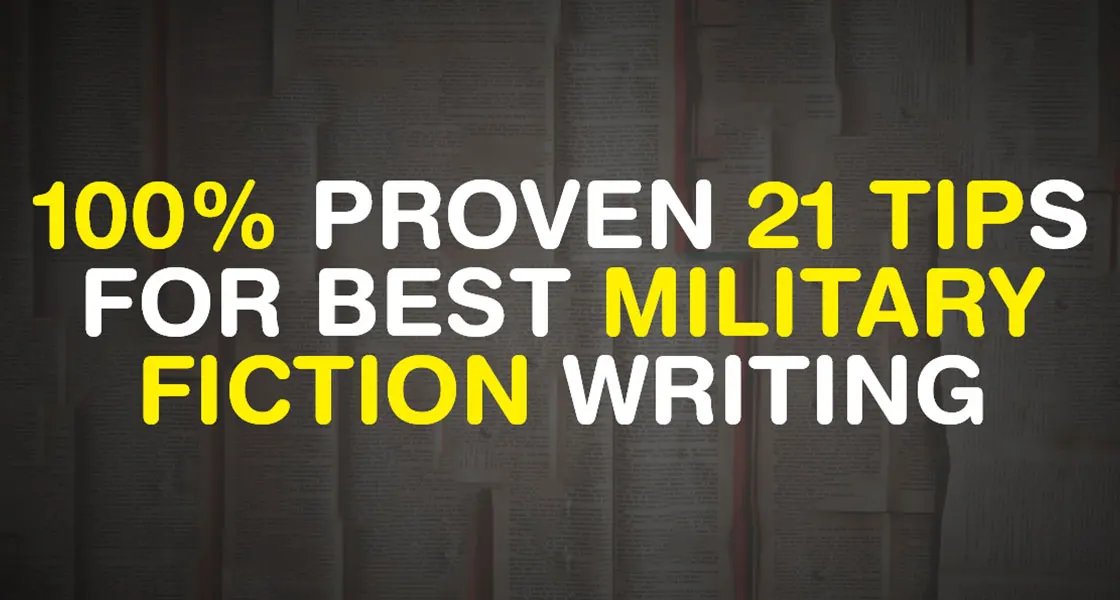Table of Contents
ToggleExclusive 21 Tips on Military Fiction Writing 2023

Ready for an exciting journey into the world of military fiction writing in 2023? Want to level up your storytelling skills with 21 powerful tips?
Whether you’re a seasoned pro or just starting, this guide has something for everyone. From crafting captivating characters to adding thrilling action scenes, we’ve got you covered. So, are you excited to grab your pen or flex those typing fingers?
Let’s dive in together and embark on this creative adventure in the realm of military fiction. Are you ready to weave stories that leave readers craving more? Let’s have some fun along the way.
No More Excuses, Start Writing your Book Now

Feeling stuck and making excuses for not writing your book? Don’t worry; we’ve got your back! With our expert guidance and proven techniques, you’ll overcome writer’s block and unleash your creativity.
Say goodbye to procrastination and hello to progress. Our exclusive tips will boost your confidence and help you finally bring your story to life. Ready to take that leap and become a published author? Let’s do this together.
1 Research is Your Best Friend
Before you start writing your military fiction, thorough research is crucial. Dive deep into military history, technology, and tactics to ensure that your narrative is both authentic and engaging. For example, if you’re writing about World War II, you should understand the strategies employed by different countries, the weaponry used, and the historical context to provide accurate details and context in your story.
2 Develop Compelling Characters
Creating multi-dimensional and relatable characters is essential. To achieve this, delve into their backgrounds, motivations, and fears. For instance, if your protagonist is a soldier, explore their past experiences, the reasons they joined the military, and the personal struggles that make them human.
3 The Power of Dialogue
Crafting natural and authentic dialogue is an art. Use military jargon sparingly to avoid overwhelming your readers, ensuring your characters’ conversations feel real. For instance, in a military setting, characters should communicate with the right balance of formality and camaraderie, reflecting their roles and relationships.
4 Set the Stage with Vivid Descriptions
Immerse your readers in the battlefield by providing vivid descriptions of landscapes, weaponry, and equipment. Engage their senses to make them feel like they’re part of the action. For instance, describe the gritty texture of a soldier’s uniform, the acrid smell of gunpowder, or the deafening roar of a tank’s engine.
5 Pace Your Storytelling
Maintain a balance between intense action scenes and moments of reflection or character development. This ensures that your readers stay engaged throughout your military fiction. For example, follow a gripping combat scene with a quiet moment where the characters process their experiences and emotions.
6 Understand the Rules of Engagement
Familiarize yourself with military rules and protocols to ensure accuracy. Mistakes can break reader immersion, especially for those with military knowledge. For instance, knowing the correct way to address a superior officer or the proper handling of firearms is crucial.
7 Incorporate Emotional Rollercoasters
Military fiction should evoke a range of emotions. Make your readers laugh, cry, and cheer for your characters. Emotional highs and lows are essential for a captivating narrative. For example, show the camaraderie among soldiers, the fear of facing an enemy, and the relief of returning home.
8 Create Believable Battles
Combat scenes should mirror the chaos and unpredictability of real-life battles. Avoid clichés and let events unfold organically. Describe the fog of war, the fog of confusion, and the fog of uncertainty that soldiers face during intense firefights.
9 Show, Don't Tell
Show, don’t tell is a fundamental writing technique. Instead of narrating events, reveal them through actions and emotions. This deepens the reader’s connection with the characters and story. For instance, rather than saying a character is brave, depict their courageous actions and inner struggles.
10 Draw Inspiration from Real-Life Heroes
Real-life military heroes can inspire your characters. Their bravery and sacrifice can add an authentic touch to your narrative. Research individuals like Audie Murphy or Audie L. Murphy for examples of incredible valor and heroism to infuse into your characters’ backgrounds.
11 Tug at Heartstrings
Explore the emotional impact of war on soldiers and civilians. Portray the human cost of conflict to evoke empathy and understanding. Highlight the trauma, loss, and resilience of characters affected by war.
12 Include Twists and Turns
To keep readers engaged, incorporate unexpected plot twists and surprises. Unpredictability adds excitement to your military fiction. For instance, introduce a sudden betrayal or a hidden agenda that turns the story on its head.
13 Edit, Edit, Edit
Polishing your work through the editing process is essential. Eliminate grammatical errors and refine your storytelling for a smoother read. Editing ensures that your military fiction is polished and free of distractions that could pull readers out of the story.
14 Seek Feedback
Share your draft with fellow writers or beta readers to get valuable feedback. Constructive criticism can help you identify areas of improvement, from character development to pacing and plot coherence.
15 Harness the Power of Foreshadowing
Foreshadowing is a literary technique that can significantly enhance your military fiction. It involves dropping subtle hints or clues about future events, creating suspense and anticipation among your readers. This technique serves to engage the audience’s imagination and keep them eagerly turning the pages to see how the story unfolds.
For example, in Tom Clancy’s “The Hunt for Red October,” the author uses foreshadowing to hint at the Soviet submarine’s revolutionary propulsion system. These hints build tension and curiosity, making the eventual revelation more satisfying.
Foreshadowing can be as simple as cryptic dialogue, a mysterious object, or a character’s premonition. It creates a sense of intrigue and excitement as readers actively participate in piecing together the puzzle.
Incorporate foreshadowing throughout your military fiction, providing readers with a sense of anticipation and reward as they discover the connections between these hints and the story’s eventual outcomes. This technique is a valuable tool for crafting a compelling narrative that keeps readers engaged and eager to learn more.
16 Balancing Fact and Fiction
While authenticity is crucial, remember that military fiction allows for creative liberties. Strike a balance between real-world accuracy and fictional elements. This allows you to create an engaging story while maintaining credibility.
17 Research Weaponry and Technology
Stay up-to-date with the latest military technology and weaponry to create realistic and believable battle scenes. Incorporate accurate details about the weapons, gear, and technology your characters use in their missions.
18 Craft Engaging Action Sequences
Write action sequences with clarity, avoiding overly complex maneuvers. Focus on the emotional impact and consequences of each battle. Describe the adrenaline, fear, and consequences of combat to draw readers into the heart of the action.
19 Show the Aftermath
Explore the psychological and physical aftermath of war on your characters. The scars of conflict can be as powerful as the battles themselves. Address the long-term effects of trauma, injuries, and loss on your characters’ lives.
20 Character Growth and Arcs
Allow your characters to evolve throughout the story. Each experience should shape them in significant ways. Show their growth, adaptation, and transformation in response to the challenges and conflicts they face. This dynamic character development adds depth to your military fiction.
21 A Memorable Ending
In military fiction, a memorable ending is essential to leave a lasting impression on your readers. The conclusion should be powerful, thought-provoking, and satisfying. It’s the final opportunity to tie up loose ends, provide resolution, and deliver an emotional impact.
A powerful ending can take different forms. It might be a heroic sacrifice, a surprising twist, or a reflection on the human cost of war. For example, in “The Things They Carried” by Tim O’Brien, the conclusion brings together the emotional weight of the soldiers’ experiences and the lasting impact of the Vietnam War on their lives.
Thought-provoking conclusions often leave readers pondering the broader implications of the story. They can challenge the reader’s perspective on war, morality, or the human condition. For instance, the ending of “Catch-22” by Joseph Heller is both darkly comedic and deeply reflective, prompting readers to question the absurdity of war.
A satisfying ending provides closure to character arcs and storylines, giving readers a sense of fulfillment. For instance, in “Band of Brothers” by Stephen E. Ambrose, the final chapters show the post-war lives of the Easy Company soldiers, offering closure and celebrating their enduring bonds.
Incorporating these elements into your military fiction’s conclusion will ensure that your readers are left with a lasting impression, making your story more impactful and memorable.
Conclusion:
You’ve made it to the end of our exhilarating journey through the 21 tips for writing thrilling military fiction. Now, it’s time to put pen to paper (or fingers to keyboard) and start weaving your own action-packed tales.
So, what are you waiting for? Embrace the challenge, embrace the adventure, and create military fiction stories that will captivate readers and leave them hungry for more.
FAQs
Yes, but ensure you handle them with respect and accuracy, as some events may still be sensitive for some readers.
Research extensively, consult experts, and avoid stereotypes. Sensitivity and empathy are crucial.
Both options are valid, but using existing ranks can add authenticity.
Focus on the human cost and the consequences of conflict to create a balanced portrayal.
If it serves the story and feels natural for your characters, go for it!
Absolutely! It can add depth to your narrative and showcase different viewpoints.
Use jargon sparingly and provide context or explanations when necessary.
Not necessarily. You can explore other perspectives, like civilians caught in the conflict.
Libraries, online resources, documentaries, and firsthand accounts from veterans are great places to start.
Of course! Genres like sci-fi, fantasy, or romance can be blended creatively with military fiction.
Create obstacles, add surprises, and keep your characters on their toes.
It’s crucial for authenticity, but you can also explore how characters challenge authority in certain situations.